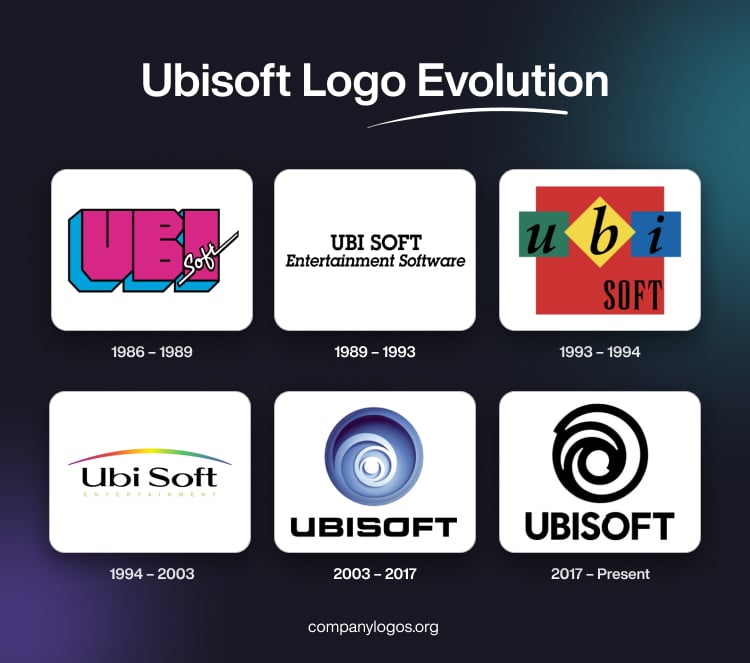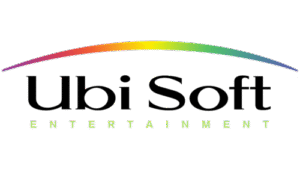
Ubisoft is one of the leading video game publishers in the world with a rich and dynamic history. Its journey over the years is marked by innovation, strategic expansion, and the creation of some of gaming’s most iconic franchises. It began its journey as a French family business and has since achieved the status of a global industry powerhouse. The Ubisoft journey reflects both the evolution of the video game industry and the company’s relentless drive to push creative boundaries. Over the decades, the logo has undergone several changes, wherein each reflects a new chapter in Ubisoft’s corporate identity and creative ambitions.
The Genesis of the Ubisoft Logo (1986 – 1989)
The original logo of Ubisoft was introduced in 1986, and it constituted a bold and colourful wordmark. The logo featured thick, 3D-style letters “U”, “B”, and “I” in pinkish-purple and light blue. It had the word “soft” in a cursive script resembling a handwritten white font. This vibrant design was characteristic of the 1980s and conveyed a sense of trust, calm, and assertiveness. It was fitting for a new company that was entering the entertainment software market.

(1989 – 1993)
In 1989, Ubisoft shifted to a more professional and minimalist logo. The new design was black and white, with “UBISOFT” in bold, uppercase sans-serif letters. Beneath it was written “Entertainment Software” in italics. This change reflected a desire for a more serious, business-like image, which was similar to the tech industry branding of the time.

(1993 – 1994)
Four years later, in 1993, Ubisoft experimented with a geometric and playful logo. The letters “U”, “B”, and “I” appeared in lowercase italics inside different coloured squares (green, yellow, and blue), respectively. The word “SOFT” was in uppercase black letters, and the whole logo elements were placed within a big red square. While this design aimed to appeal to a younger audience and highlight the company’s entertainment focus, it was short-lived due to its lack of success.

(1994 – 2003)
In 1994, after its international expansion and the launch of Rayman, Ubisoft introduced a new logo that featured a simple black serif wordmark under a rainbow arch. Below, the word “Entertainment” in a smaller size appeared in spaced-out, sans-serif letters. The rainbow symbolised universality and inclusivity and aligned with Ubisoft’s goal to create games for a global and diverse audience. This design also resonated with the colourful tech branding trends of the era.

(2003 – 2017)
A major turning point came in 2003, after Ubisoft acquired the Tom Clancy license and shifted towards more mature and diversified content. The company unveiled the now-iconic spiral or “swirl” logo. This design featured a grey spiral with an “eye” at its centre and was paired with a block-like, sans-serif “UBISOFT” wordmark. The spiral represented infinity, creativity, and the idea of being everywhere at once. This logo marked Ubisoft’s transition into a major global player in the gaming industry.

(2017 – Present)
In 2017, Ubisoft updated its logo to the current minimalist, monochrome swirl. The grey colour was removed in favour of a black-and-white, hand-drawn look. The spiral became more abstract and resembled both an “O” and a window into Ubisoft’s creative worlds. The accompanying wordmark adopted a custom “Ubisoft Sans” font. This modern design reflects Ubisoft’s focus on digital experiences, player-centric worlds, and the artistry behind its games. The logo’s simplicity also allows it to be easily animated and adapted for different franchises and media.
The spiral or swirl in the Ubisoft logo is more than a graphic—it’s a portal symbolising imagination, dynamism, and openness. It represents the interconnected nature of the gaming community and the endless possibilities within Ubisoft’s creative universes. The shift to a monochrome palette underscores sophistication and adaptability.

The Elements of the Ubisoft Logo
Symbol
The logo symbol of Ubisoft is a balanced vortex with a shifted centre. Here, the designers have deliberately steered away from achieving the perfect symmetry of the spirals.
Font
The Ubisoft logo uses the Ubisoft Sans typeface created by Colophon Founder. Developed for a French video game developer, the typeface appears similar to a modified Gilroy Extra Bold typeface. The individual sans-serif letters are simple in design, but for the letter “O”, that looks like a round chain link. It is similar to the shape of the central hand-drawn element of the logo.
Colour
The colour palette used in designing the Ubisoft logo is a monochrome black and white. Thus, although the contours of the vortex are black, the background and the gaps are displayed in white.
The History of Ubisoft
Ubisoft was founded in March 1986 in Carentoir, France, by five brothers—Christian, Claude, Gérard, Michel, and Yves Guillemot. The brothers came from a family with a background in agriculture and cider production. The Guillemot brothers initially started Ubisoft as a distributor, wherein they imported and sold computer games from other countries to the French market. The original name of the company, “Ubi Soft” (short for “ubiquitous software”), reflected their ambition to become a major player in the emerging video game industry.
By 1989, Ubisoft had released its first game, Zombi, and began expanding internationally. It had set up subsidiaries in the UK, Germany, and the US. The company soon shifted its focus toward game development and recognised its potential to create original titles.
The mid-1990s marked a period of rapid growth and creative breakthroughs for Ubisoft. In 1994, the company opened its first internal development studios in Montreuil, France, and Romania. The following year, Ubisoft launched Rayman, its first major gaming franchise. It became a critical and commercial success and established the company’s reputation for innovative gameplay and artistic design.
In 1996, Ubisoft went public and raised over $80 million to fuel further expansion and the opening of new studios. These included Ubisoft Shanghai (1996) and Ubisoft Montreal (1997). The company also began acquiring licences and forming partnerships with major entertainment brands to further diversify its portfolio.
The turn of the millennium saw Ubisoft transform into a global industry leader. In 2000, Ubisoft acquired Red Storm Entertainment and gained the rights to the Tom Clancy series. This would eventually become one of its most lucrative and enduring franchises. The company continued to expand its reach, opened studios worldwide, and acquired additional development teams.
During this period, Ubisoft launched several successful franchises, which included Prince of Persia, Far Cry, and Just Dance. Each of these contributed to the growing influence of the company in the gaming world. In 2003, Ubisoft rebranded itself by adopting the simplified “Ubisoft” name and introducing the iconic swirl logo. The company also navigated industry challenges, such as the attempted hostile takeover by Electronic Arts in 2004. This was, however, resisted, and Ubisoft successfully maintained its independence and creative direction.
Ubisoft continued to thrive in the 2010s, driven by a commitment to innovation and a diverse portfolio. The launch of Assassin’s Creed in 2007, developed by Ubisoft Montreal, marked a turning point. The series became a flagship franchise and cultural phenomenon. The company also invested in digital platforms by launching Uplay in 2013. This was done to enhance the gaming experience and connect with players directly.
Ubisoft diversified its business by exploring film adaptations, merchandise, and even theme park attractions, thereby expanding its franchises beyond traditional gaming platforms. The company’s ability to adapt to changing technologies and consumer preferences cemented its position as a visionary leader in interactive entertainment.
In recent years, Ubisoft has embraced new business models, especially moving to live service monetisation for its major titles. It generated significant revenue and kept its games relevant in a rapidly evolving market. By 2023, Ubisoft’s live service approach had helped the company generate close to $1 billion in revenue. As of 2024, Ubisoft boasts over 18,000 employees across 40 countries, with a diverse portfolio that includes franchises like Assassin’s Creed, Far Cry, Just Dance, Tom Clancy’s, Watch Dogs, Rabbids, and Rayman.
Ubisoft’s ongoing focus on innovation, global expansion, and engaging storytelling ensures its continued influence in the gaming industry.
The company remains committed to pushing the boundaries of interactive entertainment and captivating gamers worldwide.
Interesting Facts About Ubisoft
- Ubisoft was founded on March 28, 1986, in Carentoir, France, by the Guillemot brothers—Christian, Claude, Gérard, Michel, and Yves. The original name of the company was “Ubi Soft”, which was the abbreviation of “ubiquitous software”. The name reflected the ambition of the brothers to gain widespread presence in the software market.
- Before becoming a game developer and publisher, Ubisoft initially operated as a distributor. It used to import and sell games from abroad to the French market. The first published game of the company was Zombi in 1986, which sold 5,000 copies by early 1987.
- The Guillemot brothers used their family chateau in Brittany as the primary development space. They hoped the unique setting would attract talented developers and help manage expectations.
- After going public in 1996 and raising over $80 million, Ubisoft quickly expanded worldwide. It opened studios in Annecy (France), Shanghai (China), Montreal (Canada), and Milan (Italy) between 1996 and 1998.
- In 2000, Ubisoft acquired Red Storm Entertainment and gained access to the Tom Clancy brand and its popular tactical shooter series like Rainbow Six and Ghost Recon. This acquisition was a major step in establishing Ubisoft’s foothold in the U.S. market.
- In 2007, Ubisoft launched Assassin’s Creed, which was originally intended as a sequel to Prince of Persia: The Sands of Time. The game evolved into a groundbreaking franchise focused on historical settings and the conflict between Assassins and Templars. It became one of the flagship series of Ubisoft.
- Ubisoft rebranded from “Ubi Soft” to “Ubisoft” in 2003 and introduced the now-famous swirl logo, symbolising creativity, infinity, and the company’s global reach.
- Ubisoft is credited with revolutionising open-world gaming, especially with franchises like Far Cry and Assassin’s Creed, which pushed the boundaries of immersive, expansive game environments.
- In 2013, Ubisoft launched Uplay, a digital distribution and multiplayer platform designed to enhance player engagement and provide a unified ecosystem for Ubisoft games.
- Ubisoft develops and publishes games across many genres, including shooters, adventure, dance, and simulation. It operates over 40 studios worldwide with approximately 19,000 employees as of 2025, making it a truly global company.
- Ubisoft was a leader in publishing games targeted at female audiences on platforms like Nintendo DS and Wii, with series such as Imagine, Ener-G, and Petz.
- In 2004, Electronic Arts purchased a 19.9% stake in Ubisoft, which Ubisoft’s leadership considered a hostile move. Ubisoft successfully resisted the takeover, and EA sold its shares in 2010, allowing Ubisoft to maintain its independence.
- Despite its successes, Ubisoft has faced challenges, including criticism for releasing unfinished games and internal management issues. These problems have affected its reputation and financial results in recent years.
- In 2008, Ubisoft celebrated 20 years of working with the Tom Clancy brand, expanding the franchise into multiple successful game series and establishing a large fan base worldwide.
Finally
Ubisoft’s logo evolution shows the journey of the company from a local French distributor to a global leader in interactive entertainment. Each logo redesign has marked a new era for the company. It has adapted to industry trends and reflects the expanding vision of Ubisoft. Today’s swirl logo design stands as a testament to the brand’s commitment to creativity, innovation, and the power of immersive worlds.